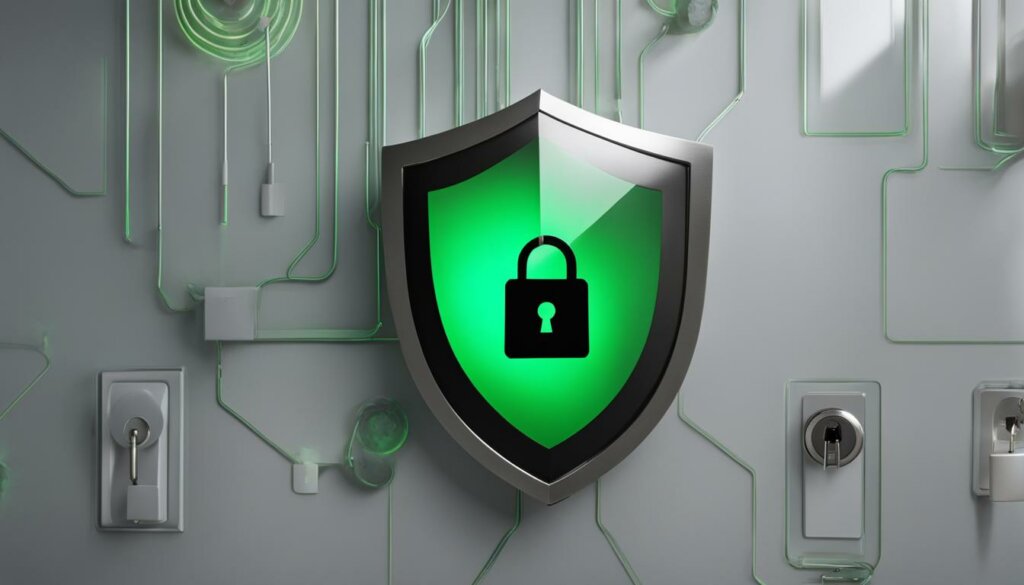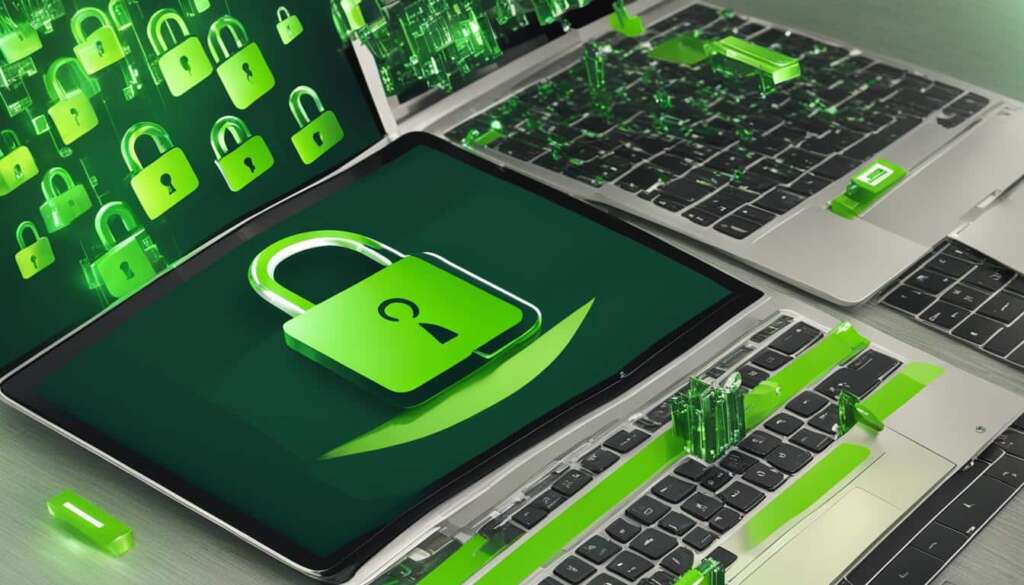Table of Contents
Welcome to our article on cybersecurity for remote workforces. As the rise of remote work continues, it is crucial to address the online security challenges that come with telecommuting. With cyber threats on the rise, organizations must implement robust cybersecurity measures to protect their remote workforce and ensure secure remote access. In this article, we will explore the importance of cybersecurity for remote workforces and provide insights into the best practices, tools, and policies that can help safeguard sensitive data. Let’s dive in!
In the current landscape, where remote work has become the norm, cybercriminals are increasingly targeting remote employees and exploiting vulnerabilities. The expansion of the attack surface, coupled with the use of public cloud services, has created new avenues for cyberattacks. In fact, there has been a staggering 238% rise in cyber incidents reported during the COVID-19 pandemic.
To address these threats, organizations must prioritize remote workforce protection. Recent surveys indicate that 78% of Chief Information Security Officers (CISOs) consider security improvements for remote employees as a top priority. It is essential to establish comprehensive cybersecurity policies and provide employees with the necessary tools and training to mitigate risks.
In the upcoming sections, we will explore how remote work impacts cybersecurity and delve into the most common risks faced by remote workers. We will also discuss best practices for securing remote access, the impact of remote work on cybersecurity costs, and strategies for building a culture of cybersecurity within remote teams.
Whether you are an employer or an employee, understanding the importance of cybersecurity in remote work environments is crucial. By implementing the right cybersecurity measures, organizations can safeguard critical data and defend against cyber threats. Join us as we explore the world of remote work cybersecurity and discover the tools and strategies that can help protect your remote workforce.
How does remote work impact cybersecurity?
Remote work has a significant impact on cybersecurity, introducing new challenges and risks for organizations. One of the main consequences of remote work is the expansion of the attack surface. With employees connecting from various locations and using different devices, the potential entry points for cyberattacks increase, creating a larger target for malicious actors.
Another challenge posed by remote work is the growth of shadow IT. When employees work remotely, they may use unsanctioned technology or tools that have not undergone proper security scrutiny. This introduces vulnerabilities and increases the risk of data breaches.
Furthermore, remote work undermines traditional perimeter defenses. Conventional security measures, such as firewalls, are designed to protect a centralized network within a physical office space. However, with employees working outside the traditional office environment, these perimeter defenses become less effective in preventing cyber threats.
Most Common Remote Working Cybersecurity Risks
The remote work environment presents various cybersecurity risks that organizations must address to protect their sensitive data and systems. Understanding these risks is crucial in developing effective cybersecurity measures. Here are some of the most common remote working cybersecurity risks:
Expanded Attack Surfaces
Remote work expands the attack surface for cybercriminals due to multiple endpoints and networking to secure. Each device used by remote workers becomes a potential entry point for cyber threats, increasing the complexity of securing the organization’s infrastructure.
Security Talent Shortages
Securing remote workers requires a skilled cybersecurity workforce. However, there is a shortage of security talent, making it challenging for organizations to find and retain qualified professionals who can effectively protect remote employees and infrastructure.
Oversight by Security Staff
With employees working remotely, there is less direct oversight by security staff, which can lead to increased instances of poor data practices. This includes sharing sensitive information through unsecured channels, unintentional data leaks, and improper handling of data, all of which can result in security breaches.
Phishing Attacks
Phishing attacks are a significant threat to remote workers. Cybercriminals use deceptive tactics to trick employees into revealing sensitive information or downloading malware. The lack of direct security oversight makes remote workers more vulnerable to such attacks.
Unsecured Hardware and Networks
Remote workers may use unsecured hardware and connect to unsecured networks, such as public Wi-Fi, increasing the risk of unauthorized access to company systems and data. Without proper security measures in place, cybercriminals can exploit these vulnerabilities to gain unauthorized access.
Vulnerabilities in Enabling Technologies
The use of enabling technologies, such as collaboration tools and remote access software, introduces new vulnerabilities that cybercriminals can exploit. These technologies require regular updates and proper configuration to ensure they are secure and do not become weak points in the organization’s cybersecurity defenses.
Misconfigurations in the Public Cloud
Organizations that leverage the public cloud for their remote work infrastructure may face misconfigurations that can expose sensitive data and systems. Misconfigured cloud resources can be easily targeted by cybercriminals, putting the organization’s security at risk.
Webcam Hacking
Remote workers often use webcams for video conferencing and other communication purposes. However, cybercriminals can exploit vulnerabilities in webcam software or gain unauthorized access to the camera, compromising the privacy and security of remote workers.
Socially Engineered Attacks
Social engineering attacks, such as phishing, rely on manipulating individuals to disclose sensitive information or perform actions that compromise security. Remote workers may be more susceptible to such attacks due to the lack of face-to-face interaction and direct oversight.
| Remote Working Cybersecurity Risks | Description |
|---|---|
| Expanded Attack Surfaces | Multiple endpoints and networking to secure increase the attack surface for cyber threats. |
| Security Talent Shortages | There is a shortage of skilled cybersecurity professionals to effectively protect remote employees and infrastructure. |
| Oversight by Security Staff | Lack of direct security oversight can lead to instances of poor data practices and security breaches. |
| Phishing Attacks | Cybercriminals employ deceptive tactics to trick remote workers into revealing sensitive information or downloading malware. |
| Unsecured Hardware and Networks | Using unsecured hardware and connecting to unsecured networks increases the risk of unauthorized access. |
| Vulnerabilities in Enabling Technologies | Enabling technologies may introduce vulnerabilities that cybercriminals can exploit. |
| Misconfigurations in the Public Cloud | Misconfigured cloud resources can expose sensitive data and systems. |
| Webcam Hacking | Webcams can be hacked to compromise the privacy and security of remote workers. |
| Socially Engineered Attacks | Remote workers may be more susceptible to social engineering attacks due to the lack of face-to-face interaction and oversight. |
Best practices for remote working cybersecurity
In order to ensure the security of remote work environments, organizations should implement a set of basic security controls and establish comprehensive remote work cybersecurity policies. These measures, coupled with appropriate data protection and vulnerability management programs, can help mitigate risks and enhance the overall security posture of remote workforces.
One of the fundamental aspects of remote work cybersecurity is the implementation of basic security controls. This includes the use of virtual private networks (VPNs) to establish secure connections between remote employees and company resources. VPNs encrypt data transmitted between devices, ensuring secure communication even when employees are accessing the network from remote locations.
Another crucial aspect is the establishment of robust remote work cybersecurity policies. These policies should outline clear guidelines and best practices for remote employees to follow. They should address topics such as password management, secure use of personal devices, and data handling procedures. Regular training and awareness programs should also be conducted to educate employees about the importance of cybersecurity and to keep them informed about the latest threats and attack vectors.
In addition to basic security controls and comprehensive policies, organizations should also focus on threat detection and incident response mechanisms. This includes the use of anti-malware software to protect endpoints from malicious software and a strong emphasis on phishing prevention. Phishing attacks continue to be a significant threat, and training employees to recognize and report suspicious emails can help prevent successful attacks.
Endpoint detection and response (EDR) solutions can further enhance the security of remote workers by providing real-time malware detection and response capabilities. These solutions monitor endpoints for suspicious activities and automatically respond to potential threats, ensuring that remote employees have the same level of protection as those working within the traditional office environment.
Table: Essential Best Practices for Remote Work Cybersecurity
| Best Practices | Description |
|---|---|
| Use VPNs | Establish secure network connections for remote employees to ensure encrypted and secure data transmission. |
| Implement Remote Work Cybersecurity Policies | Establish guidelines and best practices for remote employees to follow, covering topics such as password management and data handling procedures. |
| Conduct Regular Training and Awareness Programs | Educate remote employees about cybersecurity risks and the latest threats, ensuring they are equipped to recognize and report suspicious activities. |
| Utilize Anti-Malware Software | Deploy anti-malware solutions to protect endpoints from malicious software. |
| Focus on Phishing Prevention | Train employees to recognize and report phishing emails, emphasizing the importance of not clicking on unknown links or downloading files from unfamiliar sources. |
| Implement Endpoint Detection and Response Solutions | Use EDR solutions to provide real-time malware detection and response capabilities for remote workers. |
Remote Work and the Impact on Cybersecurity Costs
The rise of remote work has brought significant changes to the cybersecurity landscape. While remote work offers flexibility and productivity benefits, it also introduces new challenges and expenses for organizations. One of the key areas impacted by remote work is the cost of data breaches. As more employees connect remotely, the risk of cyber breaches increases, leading to higher breach incidents and associated costs.
According to recent studies, data breaches related to remote work have led to a substantial increase in breach costs. In one study, remote work-related breaches were found to be nearly $1 million more expensive than breaches in non-remote work scenarios. This increase in costs can be attributed to various factors, including the complexity of securing remote access points, the potential for more sophisticated cyberattacks, and the higher costs of incident response and remediation.
To illustrate the impact of remote work on breach costs, consider the situation in the United States. Breaches involving remote work have cost organizations approximately $600,000 more than the global average. This heightened cost is due to the additional security measures and resources required to protect remote workers and their devices. It also reflects the financial consequences of potential data loss, regulatory penalties, and reputational damage that organizations face when dealing with remote work-related breaches.
The Cost of Remote Work-Related Breaches Compared to Non-Remote Breaches
| Type of Breach | Breach Costs |
|---|---|
| Remote Work-Related | $X million |
| Non-Remote | $X million |
This table highlights the contrast in breach costs between remote work-related breaches and non-remote breaches. It demonstrates the financial impact organizations may experience when facing a breach in a remote work environment. These costs include expenses related to incident response, investigation, legal proceedings, customer notification, and restitution.
In conclusion, the shift towards remote work has not only changed how organizations operate but has also significantly impacted cybersecurity costs. The increased risk of data breaches and the associated financial implications necessitate robust cybersecurity measures and investments to protect remote workforces effectively.
Building a Culture of Cybersecurity for Remote Workers
When it comes to cybersecurity, remote workers play a crucial role in maintaining a secure environment. Organizations must foster a culture of cybersecurity, where employees understand their responsibility in safeguarding sensitive information. This culture can be built through comprehensive cybersecurity training programs that educate remote workers on best practices and potential threats.
One effective way to promote a culture of cybersecurity is by encouraging remote workers to report any suspicious activities they come across. This reporting system creates a sense of accountability and allows organizations to take immediate action in case of a potential security breach. By empowering employees to be vigilant and proactive, organizations can enhance their overall security posture.
“A strong culture of cybersecurity is vital in today’s remote work landscape. It ensures that employees understand the importance of following security protocols and are actively engaged in protecting sensitive data.”
Regular cybersecurity training sessions should cover topics such as identifying phishing emails, using strong passwords, and securing home networks. This ongoing education helps remote workers stay updated on the latest cybersecurity threats and measures, enabling them to make informed decisions when it comes to online security.

Table: Benefits of a Culture of Cybersecurity for Remote Workers
| Benefits | Description |
|---|---|
| Increased Awareness | Remote workers develop a heightened sense of cybersecurity awareness, making them more cautious when handling sensitive information. |
| Improved Response Time | A culture of cybersecurity encourages prompt reporting of any suspicious activities, allowing organizations to take immediate action. |
| Enhanced Security Measures | Employees who understand their role in cybersecurity are more likely to follow secure practices and adhere to company policies. |
| Reduced Vulnerabilities | With a strong culture of cybersecurity, remote workers are less likely to fall victim to cyber threats such as phishing scams or social engineering attacks. |
Ensuring secure remote access with VPNs
“Using a VPN helps protect sensitive information and prevents unauthorized access.”
When it comes to remote work cybersecurity, one of the most crucial aspects is ensuring secure remote access. To achieve this, organizations should provide their employees with virtual private network (VPN) access.
A VPN creates a secure network connection for remote workers, allowing for the transmission of data in a protected manner. It establishes a secure tunnel between the employee’s device and the company’s network, encrypting all data that passes through it. This encryption ensures that sensitive information remains private and cannot be intercepted by cybercriminals.
With a secure network connection through a VPN, remote employees can confidently access company resources and carry out their work tasks from any location. Whether they are working from home, a coffee shop, or a hotel, the use of a VPN provides an additional layer of protection against cyber threats.
Benefits of using VPN for remote work:
- Secure data transmission
- Protection against unauthorized access
- Encryption of sensitive information
- Access to company resources from any location
- Additional layer of protection against cyber threats
Implementing VPNs as part of a comprehensive remote work cybersecurity strategy helps ensure that sensitive data remains secure, providing peace of mind for both employees and employers.
Securing Home Networks and Devices for Remote Work
As remote work continues to be the norm, it is essential for remote workers to take proactive measures to secure their home networks and devices. Failure to do so can leave sensitive information vulnerable to cyberattacks and compromise the overall security of the remote work environment.
One crucial step remote workers can take is to change the default passwords on their home routers. Cybercriminals often exploit the use of default passwords to gain unauthorized access to networks. By changing the default password to a strong and unique one, remote workers can significantly reduce the risk of unauthorized access to their home network.
In addition to changing passwords, password protection should be implemented on all devices used for work purposes. This includes laptops, phones, and any other devices that connect to the home network. By password protecting these devices, remote workers add an extra layer of security to prevent unauthorized access in case of loss or theft.

Table: Tips for Securing Home Networks and Devices
| Best Practices | Explanation |
|---|---|
| Change Default Passwords | Default passwords are often targeted by cybercriminals. Changing them to strong and unique ones reduces the risk of unauthorized access. |
| Password Protect Devices | Implement password protection on all devices used for work to prevent unauthorized access in case of loss or theft. |
| Secure Wi-Fi Networks | Ensure the home Wi-Fi network is password protected and uses encryption protocols like WPA2. Avoid using public or unsecured networks for work purposes. |
| Keep Software and Firmware Updated | Regularly update the software and firmware on all devices to patch known security vulnerabilities and protect against emerging threats. |
| Enable Two-Factor Authentication | Add an extra layer of security by enabling two-factor authentication on all accounts and devices that support it. |
| Use a Firewall | Enable and properly configure a firewall to protect against unauthorized access and incoming threats. |
| Regularly Backup Data | Ensure important data is regularly backed up to an external hard drive or cloud storage to prevent loss in the event of a security incident. |
Furthermore, remote workers should prioritize the security of their home networks. This includes securing the Wi-Fi network by setting a strong password and using encryption protocols like WPA2. It is crucial to avoid connecting to public or unsecured networks, which can be easily compromised by cybercriminals.
Keeping software and firmware up to date is another important aspect of home network security. Regular updates help to patch known security vulnerabilities and protect against emerging threats. Remote workers should also consider enabling two-factor authentication on all accounts and devices that support it, adding an extra layer of security.
By following these best practices and implementing appropriate security measures, remote workers can help ensure the security and integrity of their home networks and devices for remote work.
Establishing remote work cybersecurity policies
Establishing remote work cybersecurity policies is crucial to ensure the protection of sensitive data and mitigate the risks associated with remote work. These policies provide guidelines and protocols for employees to follow, promoting a secure work environment.
Cybersecurity policies should include the use of encryption to safeguard data during transmission and storage. Encryption ensures that even if data is intercepted, it remains unreadable and unusable to unauthorized individuals.
Furthermore, policies should address the use of personal devices for work purposes. Restrictions can be put in place to prevent the use of unsecured devices that may have inadequate security measures. By emphasizing the use of company-provided devices or secure personal devices, organizations can minimize potential vulnerabilities.
Regular reviews of remote work cybersecurity policies are essential to keep them up to date. Technology is constantly evolving, and new threats emerge regularly. Annual reviews allow organizations to assess the effectiveness of their policies and make necessary updates to address emerging risks.
| Cybersecurity Policies | Key Elements |
|---|---|
| Encryption | Utilize encryption protocols to protect data during transmission and storage. |
| Personal Devices | Set restrictions on using personal devices for work to ensure adequate security measures. |
| Regular Reviews | Conduct annual reviews to assess policy effectiveness and address emerging risks. |
By establishing comprehensive remote work cybersecurity policies, organizations can create a secure work environment for their remote workforce. These policies not only protect sensitive data but also promote a culture of cybersecurity awareness and responsibility among employees.

Phishing Prevention for Remote Workers
Phishing scams pose a significant threat to remote workers, making email security a crucial aspect of cybersecurity. Remote employees are often targeted through email, with malicious actors trying to trick them into revealing sensitive information or downloading harmful files. Implementing effective phishing training programs can help remote workers recognize and avoid such scams, minimizing the risk of breaches.
Organizations should provide comprehensive training on identifying phishing emails, emphasizing the importance of not clicking on unknown links or downloading files from unfamiliar sources. By educating remote workers about the tactics used by cybercriminals, employees can become more vigilant and proactive in protecting themselves and their organizations.
It is equally important to establish clear instructions for reporting phishing emails. Employees should know who to contact and what immediate action steps to take in case they inadvertently click on a malicious link. A prompt response can help mitigate the potential damage and prevent further infiltration into the company’s systems.

By prioritizing phishing prevention and providing the necessary training and support, organizations can strengthen the cybersecurity defenses of their remote workforce. With a heightened awareness of phishing scams and a proactive approach to email security, remote workers can play a pivotal role in safeguarding sensitive data and maintaining a secure remote work environment.
Endpoint Detection and Response for Remote Work
In the era of remote work, endpoint detection and response (EDR) solutions have become crucial for protecting organizations and their remote employees from malware and other cyber threats. With the increased reliance on remote work, it is essential to ensure that remote employees have the same level of protection as they would in the office environment.
EDR solutions provide real-time malware detection and response capabilities, enabling organizations to respond swiftly to potential threats. By continuously monitoring and analyzing endpoint activities, these solutions can detect and block suspicious behavior, preventing the compromise of remote employees’ devices and ensuring the security of sensitive data.
Implementing an EDR solution allows organizations to proactively identify and respond to cyber threats, enhancing their remote employee protection measures. The solution’s ability to interrupt the download process upon detecting a threat provides an added layer of defense against malware and other malicious activities.
With the ongoing rise of remote work, organizations must invest in robust endpoint detection and response solutions to safeguard their remote workforce and mitigate the risks associated with cyberattacks and data breaches.
Table: Benefits of Endpoint Detection and Response for Remote Work
| Benefit | Description |
|---|---|
| Real-time malware detection | EDR solutions provide immediate detection of malware threats, ensuring prompt response and mitigation. |
| Proactive threat identification | Continuous monitoring of endpoint activities allows for early identification of suspicious behavior and potential threats. |
| Immediate response capabilities | EDR solutions enable organizations to take swift action upon detecting a threat, preventing further compromise of devices and data. |
| Enhanced remote employee protection | Implementing an EDR solution ensures that remote employees have the same level of protection as in-office workers, maintaining a secure work environment. |
Conclusion
As remote work becomes more prevalent, prioritizing cybersecurity measures is crucial for ongoing security. Continuous training and monitoring, along with IT oversight, are essential for maintaining a secure remote work environment. By employing best practices, implementing secure access protocols, and building a culture of cybersecurity, organizations can effectively protect critical data and defend against cyber threats in remote workforces.
Training plays a vital role in remote work cybersecurity. Regular education sessions ensure that employees are equipped with the knowledge and skills to identify and respond to potential threats. Ongoing monitoring allows organizations to detect any suspicious activities or breaches promptly. With constant vigilance, businesses can address security incidents in a timely manner, minimizing the potential impact.
IT oversight is crucial in maintaining the security of remote workforces. By establishing robust policies and procedures, organizations can enforce secure practices and ensure compliance. Regular audits and assessments help identify vulnerabilities and gaps, allowing for timely remediation. A proactive approach to IT oversight ensures that remote workers have the necessary security measures in place to protect sensitive information.
In conclusion, remote work cybersecurity requires a comprehensive approach that includes ongoing security training, continuous monitoring, and IT oversight. By prioritizing these factors, organizations can effectively mitigate risks and safeguard their data. As remote work continues to evolve, it is imperative to stay updated with the latest cybersecurity practices and technologies to stay one step ahead of cyber threats.
FAQ
How does remote work impact cybersecurity?
Remote work significantly increases the potential attack surface that organizations must protect, as employees connect from various locations. The use of unsanctioned technology by remote workers contributes to the growth of shadow IT, which often lacks proper security scrutiny. Conventional perimeter defenses, such as firewalls, become less effective as employees work outside the traditional office environment.
What are the most common remote working cybersecurity risks?
The remote work environment brings various cybersecurity risks, including expanded attack surfaces due to multiple endpoints and networking to secure. The shortage of security talent poses challenges in adequately securing remote workers. With less oversight by security staff, employees may engage in poor data practices, such as sharing sensitive data through unsecured channels. Phishing attacks are a significant threat, and the use of unsecured hardware and networks further increases vulnerabilities. Misconfigurations in the public cloud and the risk of webcam hacking and social engineering attacks add to the remote security concerns.
What are the best practices for remote working cybersecurity?
Implementing basic security controls, such as using virtual private networks (VPNs) and strong passwords, is crucial for remote workers. Establishing a strong vulnerability management program and effective threat detection and incident response mechanisms are essential. Remote work cybersecurity policies should be put in place to guide employees and ensure adherence to security practices. The use of anti-malware software and a focus on phishing prevention are also important. Endpoint detection and response solutions provide additional protection against threats.
How does remote work impact cybersecurity costs?
The rise in remote work has not only increased cyberattacks but also led to higher costs associated with data breaches. Remote work-related breaches are more expensive, with one study indicating a nearly $1 million increase in breach costs. In the United States, breaches involving remote work have cost $600,000 more than the global average.
How can organizations build a culture of cybersecurity for remote workers?
Organizations should foster a culture of cybersecurity where employees take responsibility for their own security. Employees need cybersecurity training and awareness to follow best practices and report any suspicious activities. Building such a culture takes consistent effort, including repeated messages and training sessions.
How can organizations ensure secure remote access with VPNs?
Organizations should provide employees with virtual private network (VPN) access to ensure secure remote access. VPNs create a secure network connection for employees, allowing for secure data transmission and access to company resources from any location. Using a VPN helps protect sensitive information and prevents unauthorized access.
How can remote workers secure their home networks and devices?
Remote workers must take steps to secure their home networks and devices. Changing default passwords on home routers is essential to prevent cybercriminals from easily accessing the network. Password protecting devices used for work, such as phones and laptops, adds an extra layer of security. Avoiding unsecured networks, including public Wi-Fi, and ensuring home networks are properly secured are also important for remote work cybersecurity.
How can organizations establish remote work cybersecurity policies?
Organizations should establish remote work cybersecurity policies that outline best practices for employees. These policies should address the use of encryption, restrictions on using personal devices for work, and other security measures. Employees should sign the policies and review them annually during performance reviews to reinforce the importance of cybersecurity.
How can remote workers prevent phishing scams?
Remote workers are susceptible to phishing scams, which can lead to significant breaches. Organizations should provide training on recognizing and avoiding phishing emails. Employees should be instructed not to click on unknown links or download files from unknown sources. Clear instructions on reporting phishing emails and immediate action steps in case of clicking on malicious links should also be provided.
How does endpoint detection and response protect remote workers?
Endpoint detection and response (EDR) solutions help protect remote workers from malware and other threats. These solutions provide real-time malware detection and response, ensuring remote employees have the same level of protection as they would in the office. If a threat is detected, the EDR solution interrupts the download process, preventing the compromise of the device.
Source Links
- https://www.techtarget.com/searchsecurity/tip/Remote-work-cybersecurity-12-risks-and-how-to-prevent-them
- https://securityintelligence.com/articles/securing-remote-workforce-to-reduce-cyber-threats/
- https://www.businessnewsdaily.com/15701-remote-cybersecurity.html







